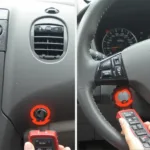Understanding OBD2 codes is crucial for any Ford owner. Whether you’re a seasoned mechanic or a DIY enthusiast, knowing how to interpret these codes can save you time and money. This guide provides a comprehensive look at OBD2 codes specific to Ford vehicles, helping you diagnose issues and get back on the road quickly.
Decoding Ford OBD2 Codes
Ford, like other manufacturers, uses standardized OBD2 codes, but certain codes can have Ford-specific meanings. These codes are generated by your vehicle’s onboard computer when it detects a malfunction in the engine, transmission, emissions system, or other critical components. Understanding these codes is the first step towards accurate diagnosis and repair. Whether your Ford is displaying a check engine light or experiencing performance issues, this guide will help you decipher the cryptic messages hidden within your car’s computer.
Common Ford OBD2 Codes and Their Meanings
Here are some of the most frequently encountered OBD2 codes in Ford vehicles:
- P0171 and P0174: These codes indicate a lean air/fuel mixture, meaning there’s too much air and not enough fuel. Potential causes include vacuum leaks, faulty oxygen sensors, or a malfunctioning mass airflow sensor.
- P0300: This signifies a random misfire, which can be caused by various issues like bad spark plugs, faulty ignition coils, or fuel delivery problems.
- P0420: This code often points to a catalytic converter problem, indicating that it’s not working efficiently.
- P0442: This code signals a small evaporative emission system leak, which could be due to a loose gas cap, a cracked EVAP line, or a faulty purge valve.
How to Read Ford OBD2 Codes
Accessing your Ford’s OBD2 codes requires an OBD2 scanner. Connect the scanner to the OBD2 port, usually located under the dashboard on the driver’s side. Turn the ignition on without starting the engine, and the scanner will retrieve the codes stored in your car’s computer. Some advanced scanners also provide real-time data and troubleshooting information.
Diagnosing Ford OBD2 Codes
Simply reading the code is just the starting point. Diagnosing the underlying problem requires further investigation. Consult a reliable repair manual or online resource for specific troubleshooting steps related to the code. You can also use online OBD2 code lookup tools to understand the potential causes and solutions. Keep in mind that a single code can have multiple causes, so thorough diagnosis is essential.
Beyond the Codes: Understanding the Ford Diagnostic System
Ford vehicles often have unique diagnostic procedures and tools beyond the standard OBD2 protocol. For more complex issues, consulting a Ford specialist or using Ford-specific diagnostic software may be necessary. This specialized software can access more in-depth data and perform advanced functions like module programming and key coding.
What if I Can’t Find My Ford OBD2 Code?
While this list covers common codes, not every code is listed. If you encounter a code not covered here, use an online OBD2 code lookup tool specifically for Ford vehicles. This will provide you with a more detailed description of the problem and possible solutions.
 Online Ford OBD2 Code Lookup
Online Ford OBD2 Code Lookup
Conclusion: Empowering Ford Owners with OBD2 Knowledge
Understanding Ford OBD2 codes is an empowering tool for every Ford owner. From minor issues to more complex problems, knowing how to interpret these codes allows you to make informed decisions about repairs and maintenance. Whether you’re a seasoned DIYer or prefer taking your vehicle to a mechanic, being familiar with OBD2 codes provides valuable insight into your Ford’s health and performance. This knowledge can save you time and money, keeping your Ford running smoothly for years to come.
FAQ
- What does the check engine light mean? The check engine light can indicate a range of issues, from minor emissions problems to serious engine malfunctions. An OBD2 scanner is needed to retrieve the specific code.
- Where can I find the OBD2 port in my Ford? The OBD2 port is typically located under the dashboard on the driver’s side.
- Can I fix the problem myself after reading the code? Some issues can be fixed with simple DIY solutions, while others require professional expertise.
- Are all OBD2 scanners compatible with Ford vehicles? Most standard OBD2 scanners are compatible, but some Ford-specific scanners offer advanced functionality.
- How often should I check my Ford’s OBD2 codes? It’s a good practice to check the codes whenever the check engine light illuminates or if you experience performance issues.
- Can I clear the OBD2 codes myself? Yes, you can clear the codes with an OBD2 scanner, but this won’t fix the underlying problem.
- What if the check engine light comes back on after clearing the codes? If the light returns, it means the issue hasn’t been resolved and requires further diagnosis.
Common Scenarios:
- Scenario 1: Check engine light is on, car runs rough. Possible cause: Misfire (P0300 series codes).
- Scenario 2: Gas smell, check engine light on. Possible cause: EVAP leak (P0442, P0455, etc.).
- Scenario 3: Poor fuel economy, check engine light on. Possible cause: Oxygen sensor issue (P0171, P0174).
Further Reading:
- Ford-Specific OBD2 Code Lookup Tools
- Understanding Ford’s Diagnostic Systems
- DIY Car Repair Guides for Ford Vehicles
If you need support, please contact us via WhatsApp: +1(641)206-8880, Email: [email protected]. We have a 24/7 customer support team.

